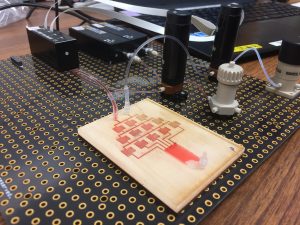As nonbiodegradable plastics continue to pollute our land and oceans, countries are starting to ban the use of single-use plastics. In this paper, we demonstrated the fabrication of wood-based microfluidic devices and their adaptability for single-use, point-of-care (POC) applications. These devices are made from easily sourced renewable materials for fabrication while exhibiting all the advantages of plastic devices without the problem of nonbiodegradable waste and cost. To build these wood devices, we utilized laser engraving and traditional mechanical methods and have adapted specific surface coatings to counter the wicking effect of wood. To demonstrate their versatility, wood microfluidic devices were adapted for (i) surface plasmon coupled enhancement (SPCE) of fluorescence for detection of proteins, (ii) T-/Y-geometry microfluidic channel mixers, and (iii) devices for rapid detection of microbial contamination. These provide proof of concept for the use of wooden platforms for POC applications. In this study, we measured the fluorescence intensities of recombinant green fluorescent protein (GFP) standards (ranging from 1.5-25 ng/μL) and 6XHis-G-CSF (ranging from 0.1-100 ng/μL) expressed in cell-free translation systems. All tested devices perform as well as or better than their plastic counterparts.
https://www.ncbi.nlm.nih.gov/pubmed/31361950
